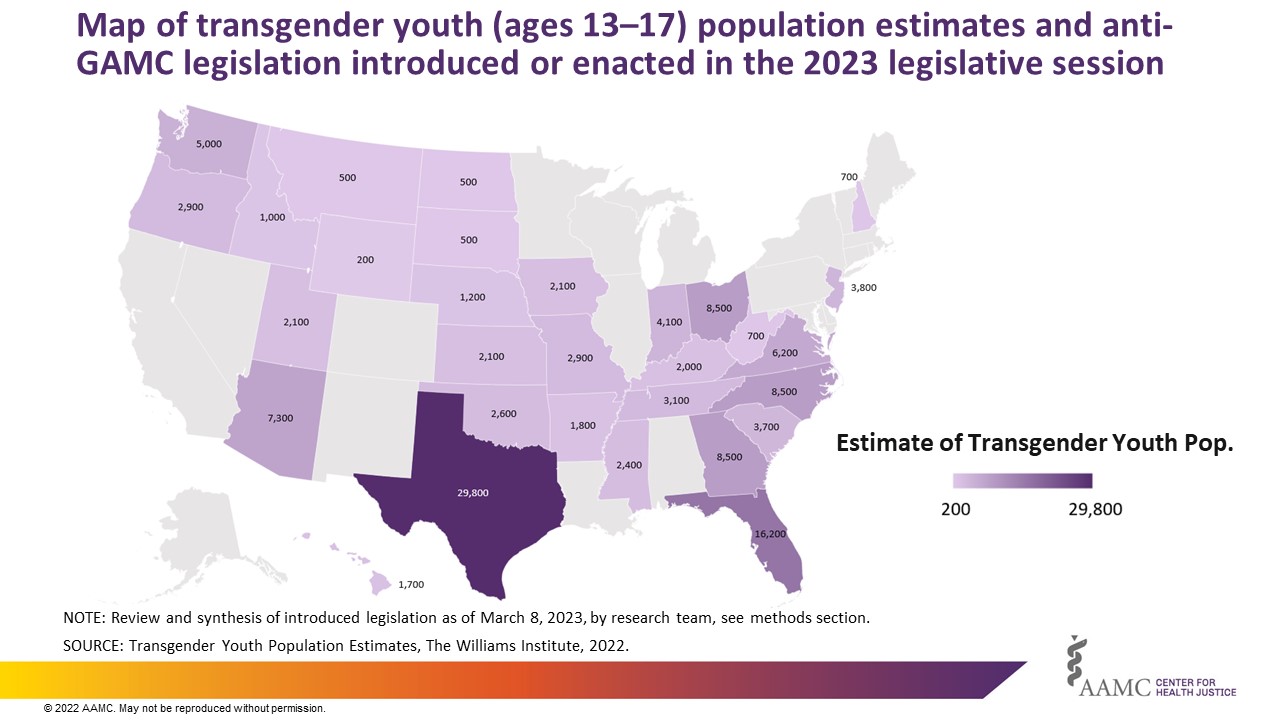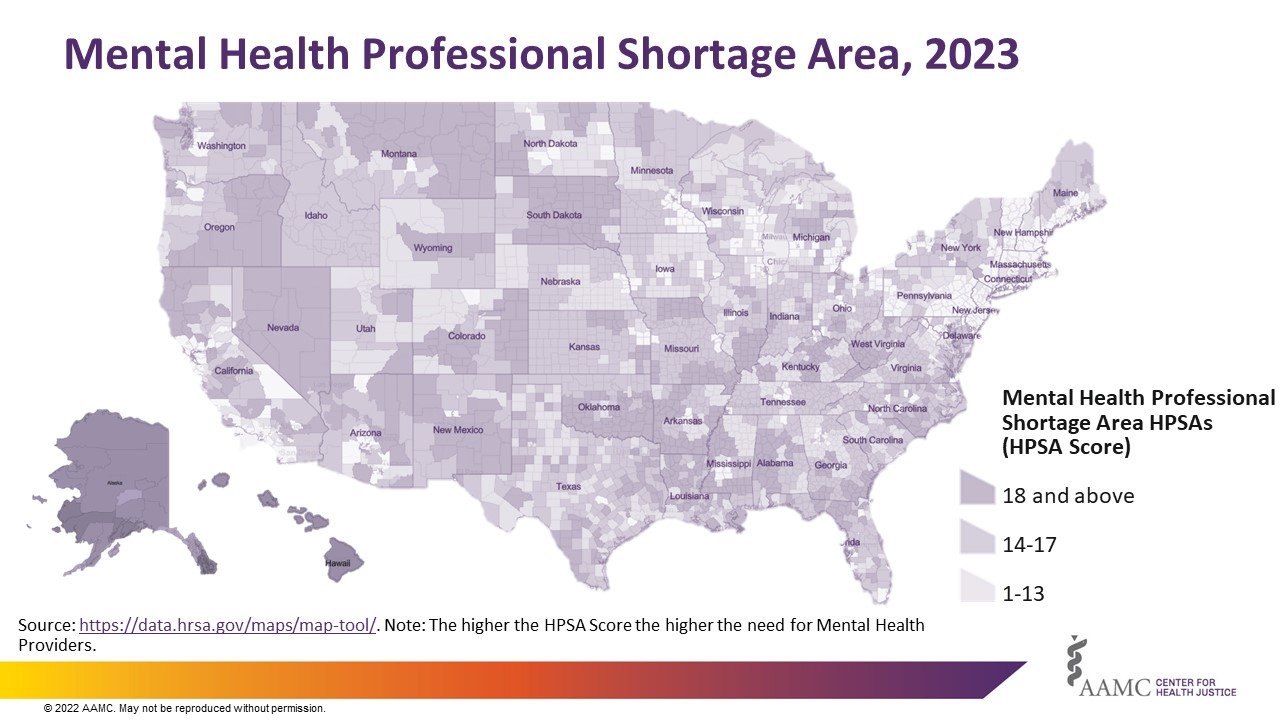| Highlights |
|---|
|
The United States offers some of the best health care in the world, if it can be accessed. Structural inequities to access — such as geographical availability, financial barriers, and policies that dictate the provision of health care services — create group differences in health that are avoidable, unnecessary, and unjust.1 To achieve health equity and ensure all communities thrive, we must identify and rectify discriminatory policies, laws, regulations, and practices that limit opportunity for health and well-being.
The unprecedented surge in 2023 of legislation across states (Figure 1) aiming to further restrict access to gender-affirming medical care (GAMC), if enacted, will limit access to medically indicated health care and exacerbate mental health inequities for transgender youth. Legislative and other policy efforts to restrict GAMC jeopardize the doctor-patient relationship and undermine the premise that physicians are trained to work with patients and their caretakers to make evidence-based, medically appropriate decisions.2
Although legislation is only one tactic being deployed to suppress the presence and participation of transgender youth in society (others include executive orders and state medical board rule decisions), this brief focuses on state legislation seeking to limit or ban GAMC introduced as of March 8, 2023. We estimated the number of transgender youth who would be denied access to medically indicated health care should the current anti-GAMC bills pass, as well as the number of transgender youth residing in states that have already banned GAMC.

Social Discrimination, Stigma, and Gender Dysphoria Harm the Mental Health of Transgender Youth
Transgender youth are individuals whose gender identity, or innate sense of their own gender, is different from the sex that they were assigned at birth. Approximately 300,000 (1.4%)b adolescents ages 13–17 in the United States are transgender.3 Relative to their non-transgender peers, transgender youth are at elevated risk for anxiety, depressed mood, and suicidal ideation and attempts.4–8 Transgender teens’ elevated mental health risk is associated with their experiences of gender-related stigma (e.g., rejection, bullying, discrimination)4,9,10 and gender dysphoria,11,12 the persistent psychological distress that arises from incongruity between gender identity and external physical traits, (i.e., their sex assigned at birth).13 Recent evidence suggests that 35% - 45% of high-school-aged transgender youth considered or attempted suicide in the past year,14 a rate that is more than double their cisgender (i.e., non-transgender) peers.
GAMC is an effective strategy for improving transgender adolescents’ mental health and well-being and consists of a range of social, psychological, behavioral, and medical treatments to affirm a person’s gender identity by aligning their experiences and expression with their sense of self.15,16 Transgender youth who receive social and medical support to affirm their gender identities show rates of depression and suicidality that are comparable to youth in the general population.17,18
It is important to understand the spectrum of GAMC. For prepubescent adolescents, gender affirming care consists of support for social transitions such as changes in name, pronouns, appearance (e.g., hair, dress), and use of gendered spaces such as bathrooms and locker rooms.7,18–21 Around puberty, adolescents and their parents or guardians may consider GAMC in consultation with medical and mental health providers. When medically indicated, GAMC may include the use of medications for pubertal suppression. Pubertal suppression creates a temporary and reversible pause in the development of secondary sex characteristics (e.g., changes in voice, body composition, and body hair) that are often misaligned with an adolescent’s gender identity,15,22 which can create or intensify gender dysphoria or psychological distress. Following pubertal suppression, some adolescents — in conjunction with their parents and clinical providers — may opt to receive gender affirming hormone therapy (e.g., testosterone, estrogen) that induce secondary sex characteristics that align with their gender identity.
GAMC Improves Mental Health Outcomes for Transgender Youth
Extensive, peer-reviewed medical research indicates that GAMC is associated with improved mental health and psychosocial functioning among transgender youth. In studies that followed transgender youth over time, those who received GAMC in the form of pubertal suppression and/or gender affirming hormones reported decreased depression,23,24–26 anxiety,24,25 body dissatisfaction,25 gender dysphoria,27 and suicidality,23 and reported improved psychological functioning,12,27 life satisfaction,24 and quality of life.23 In a recent study, after receiving GAMC, the subjective well-being and quality of life of transgender youth were comparable to same-aged peers from the general population.27 Another study found that rates of suicidality among transgender youth receiving GAMC mirrored those in the general population, whereas transgender youth who were referred for GAMC but had yet to receive it reported elevated rates of suicidality.17
GAMC is recommended and supported by 29 major medical organizations, including the American Academy of Pediatrics,28 the American Medical Association (AMA),29 and the Endocrine Society.21 The American Academy of Child and Adolescent Psychiatry30 and the American Psychiatric Association31 view GAMC as evidence-based clinical care, and the AMA supports the provision of medical insurance coverage for GAMC.32 GAMC is developmentally appropriate and medically necessary for youth who meet internationally recognized guidelines for treatment.15,22,28,33
Gender-affirming medical care (GAMC) is an internationally recognized standard of care for transgender adolescents.15,22 It is safely provided under the supervision of a licensed medical professional and in conjunction with parental or guardian consent.15 GAMC guidelines for prepubescent minors do not include surgery and puberty resumes if puberty-delaying medication is stopped.15,22 When indicated, GAMC is associated with lower suicidality and depression and improved quality of life among transgender youth.23,39
Legislation Restricting Access to GAMC Endangers Transgender Youth and Their Families
Despite the scientific and clinical evidence demonstrating the positive impacts of GAMC and endorsement of GAMC from major medical organizations, in 2023, 30 states (as of March 8, 2023) proposed or enacted legislation that would ban and/or criminalize GAMC for adolescents and young adults. If these proposals are passed, our conservative estimate indicates that more than 132,600 transgender youth — more than one-third of all transgender youth in the United States — will lose access to the availability of clinically recommended, life-saving health care (Table 1). Already, 20,600 transgender youth live across 7 states (Alabama, Arizona, Arkansas, Mississippi, South Dakota, Tennessee, and Utah) that have enacted anti-GAMC state legislation.
A review of recently proposed legislation demonstrated that the tactics aimed at eliminating GAMC range from the negation of care in public and private spheres, to the restriction of parental or guardian rights, to professional and legal punishment of health care providers for the provision of GAMC. In some states, parents or guardians who continue to support receipt of GAMC could face criminal charges or allegations of child abuse or neglect.34 Medical providers who deliver this care may also be subject to disciplinary and legal actions that range from licensure misdemeanors to felonies.34,35 Other tactics include forbidding the use of public monies and private health insurance plans to cover health care that supports gender affirmation.
Even without these proposed barriers to health care and GAMC, families with transgender youth already experience long waits and shortages of appropriate GAMC providers.36 Enacting additional policies will eliminate opportunities to support the health and well-being of children in families who seek GAMC. For those with the financial means, adolescents and their families will be forced to travel to other states to access care. Yet, with the expansion of anti-GAMC policies, that option may no longer exist, leaving no access to medical treatment.
GAMC Restrictions Will Exacerbate the Mental Health Care Access Crisis
Limiting or banning GAMC exposes transgender youth to short- and long-term social and mental health impacts of unmitigated gender dysphoria, including increased risk of suicidal thoughts, self-harm, suicide attempts, and other forms of violence and victimization.37 States that enact these policies will likely observe an increase in the number of youth who experience suicidal thoughts, engage in self-harm and suicidal behavior, and require state funds for clinical and mental health services — a consequence that the United States is not equipped to address due to the longstanding shortage of mental health professionals (Figure 2).38

Protect Evidence-Based Medicine, Promote Health Justice, Protect GAMC
The medical community endorses the merits of GAMC as a medical treatment to address the medical and mental health needs of transgender youth. The enactment of laws and policies seeking to limit access to GAMC is not evidence-based, but instead reflects a politically calculated dehumanization and scapegoating of transgender youth. Major medical associations endorse medically indicated GAMC as necessary for transgender youth health. These strategies are essential to supporting the positive development of transgender youth. Policies that restrict access to GAMC will inevitably increase risk for psychological distress, poor mental health, and suicidality among transgender youth. As a result, the AAMC has joined state-level amicus briefs in a coordinated effort by “professional medical and mental health organizations seeking to ensure that children and adolescents receive optimal medical and mental healthcare they need and deserve.”40,41,42
Health justice demands that we leverage law, regulation, and policy to create health opportunities for all communities, especially and explicitly those that are and have been systematically marginalized. Pulling those same levers to deny any community’s health and well-being, and instead to do them actual harm, is unjust. Supporting GAMC is a matter of health justice.
Table 1. Estimated Transgender Youth Population, Ages 13-17, in the 30 States that have Proposed or Enacted Anti-GAMC Legislation in 2023c.
| State | Estimate of Trans Youth (Number) |
|---|---|
| AR | 1,800 |
| AZ | 7,300 |
| FL | 16,200 |
| GA | 8,500 |
| HI | 1,700 |
| IA | 2,100 |
| ID | 1,000 |
| IN | 4,100 |
| KS | 2,100 |
| KY | 2,000 |
| MO | 2,900 |
| MS | 2,400 |
| MT | 500 |
| NC | 8,500 |
| ND | 500 |
| NE | 1,200 |
| NH | 700 |
| NJ | 3,800 |
| OH | 8,500 |
| OK | 2,600 |
| OR | 2,900 |
| SC | 3,700 |
| SD | 500 |
| TN | 3,100 |
| TX | 29,800 |
| UT | 2,100 |
| VA | 6,200 |
| WA | 5,000 |
| WV | 700 |
| WY | 200 |
SOURCE: Transgender Youth Population Estimates, The Williams Institute, 2022.
Access References and Additional Resources
Authors
Philip M. Alberti, PhD
Founding Director, AAMC Center for Health Justice
Carla S. Alvarado, PhD, MPH
Director of Research, AAMC Center for Health Justice
Meg D. Bishop, PhD
Postdoctoral Research Fellow, Department of Family Science and Affiliate, University of Maryland Prevention Research Center
University of Maryland, College Park
Diane M. Cassidy, MLIS
Research Team, AAMC Center for Health Justice
Jessica N. Fish, PhD
Assistant Professor, Department of Family Science and Deputy Director for Research and Evaluation, University of Maryland Prevention Research Center
University of Maryland, College Park
Allen B. Mallory, PhD
Assistant Professor of Human Development and Family Science in the Department of Human Sciences
The Ohio State University
Samantha A. Moran, LMSW
Graduate Student, Department of Family Science
University of Maryland, College Park
Sarah Piepenbrink
Communications Manager, AAMC Center for Health Justice
Phoebe Ramsey, JD
Policy Team, AAMC Center for Health Justice
The authors thank and acknowledge Whitman-Walker Institute, Translegislation.com, and The Trevor Project for their contributions in the development of this brief.